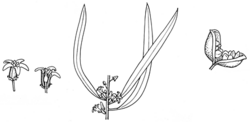Common name: Weeping Pittosporum, Butterbush, Berrigan
Pittosporum angustifolium Lodd., G.Lodd. & W.Lodd. APNI* Synonyms: Pittosporum phillyraeoides auct. non (DC.) Benth. APNI*

Description: Shrub or tree to c. 10 m high, almost glabrous throughout; branches pendent.
Leaves alternate, oblong or linear or narrowly elliptic, 4–12 cm long, 4–12 mm wide, falcate; margin flat, glabrous; apex with a small hooked point; petiole c. 10 mm long.
Flowers axillary, solitary or in sessile to pedunculate few-flowered axillary or terminal clusters, sometimes unisexual, fragrant. Sepals 1.5–3.5 mm long, ciliate. Petals usually 7–10 mm long, yellow to cream. Ovary glabrous.
Capsule compressed-ovoid to -globose, 8–18 mm long, smooth, glabrous, yellowish, often slightly depressed at pedicel junction; seeds usually 6–8, dark or orange-red.
Flowering: winter–spring.
Distribution and occurrence: Grows in woodland and mallee communities, and widespread on sandy soils in the arid zone, chiefly in inland districts, west from Muswellbrook.
NSW subdivisions: NWS, CWS, SWS, NWP, SWP, NFWP, SFWP
Other Australian states: Qld Vic. S.A. N.T.
Text by R. O. Makinson
Taxon concept:
APNI* Provides a link to the Australian Plant Name Index (hosted by the Australian National Botanic Gardens) for comprehensive bibliographic data
***The AVH map option provides a detailed interactive Australia wide distribution map drawn from collections held by all major Australian herbaria participating in the Australian Virtual Herbarium project.
|


